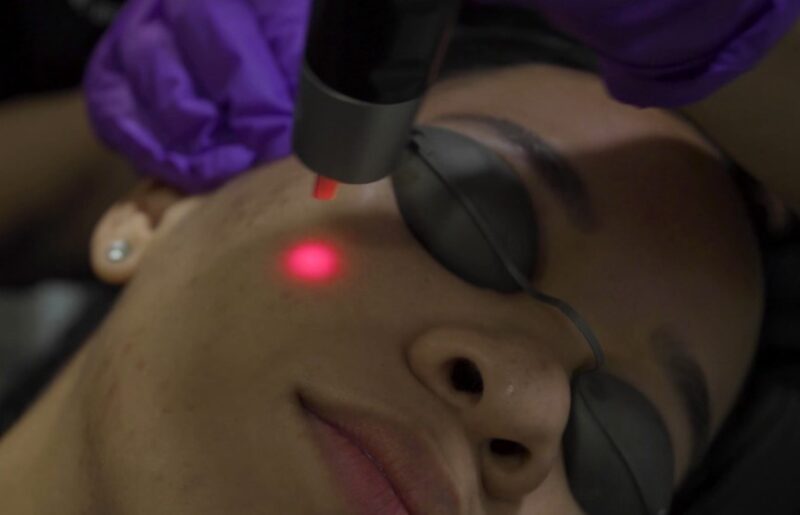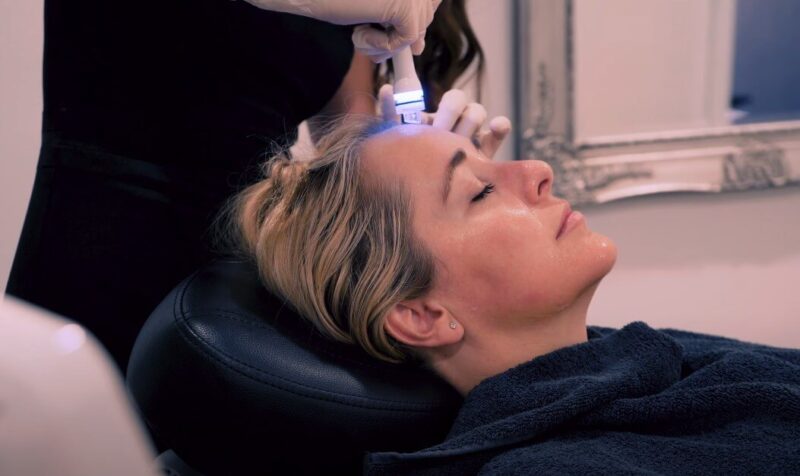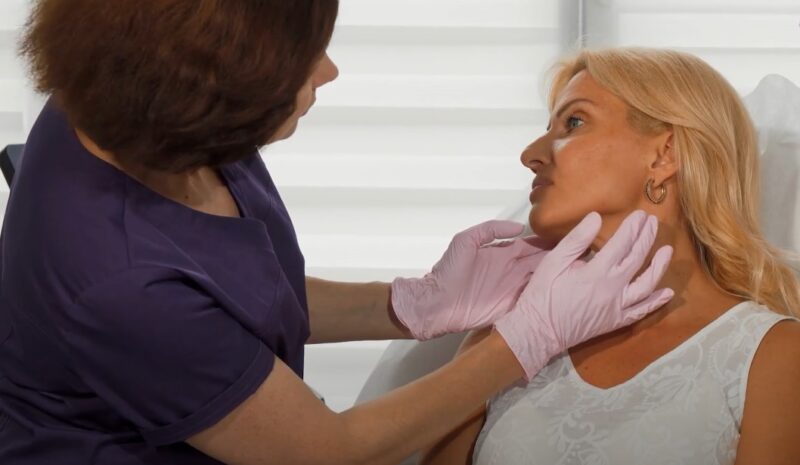Hyperpigmentation can be one of those skin concerns that feels a bit like an uninvited guest—it shows up unannounced and then overstays its welcome.
If you’ve noticed a few dark spots popping up after a sunny vacation or you’re dealing with more stubborn patches that just won’t budge, the good news is that there are ways to manage and reduce hyperpigmentation.
The key is to direct the treatment based on your skin tone. Let’s talk about what works best for different skin tones and how to go about treating those pesky dark spots.
What Causes Hyperpigmentation?

Before jumping into treatment, it’s important to have a basic idea of what’s causing those dark patches.
Hyperpigmentation happens when your skin produces too much melanin, the pigment responsible for your skin color. This can happen for several reasons, including sun exposure, hormonal changes, inflammation, and even from picking at your skin.
The type of treatment that’s best for you largely depends on your skin tone because different skin tones respond to treatments in different ways. What works wonders for someone with fair skin might not be ideal for someone with darker skin, and vice versa.
As per MarryAnn De Pietro, hyperpigmentation is a common skin condition where patches of skin become darker than the surrounding areas. This occurs due to an excess production of melanin, the pigment responsible for skin color.
Treatment Options for Fair to Light Skin Tones
If you have fair or light skin, hyperpigmentation can be especially frustrating because the contrast between dark spots and your natural skin color can be quite noticeable.
But there’s hope! Fair-skinned folks generally respond well to treatments that accelerate skin cell turnover or target melanin production directly.
Topical Treatments

One of the go-to treatments for fair skin is topical products. Ingredients like retinoids, vitamin C, and azelaic acid are great options. Retinoids speed up cell turnover, helping your skin shed those pigmented cells faster.
Vitamin C is a powerful antioxidant that brightens skin and reduces melanin production. Azelaic acid works in a similar way by slowing down the production of melanin and calming inflammation.
According to Seemal R. Desai, MD, topical treatments for hyperpigmentation, such as retinoids, hydroquinone, and azelaic acid, are effective because they target the underlying causes of excess melanin production, reduce inflammation, and promote skin cell turnover. These agents can significantly lighten dark spots and improve overall skin tone when used consistently over time.
Chemical Peels
Chemical peels might sound intimidating, but for fair skin, they can be very effective. Light chemical peels, especially those with alpha hydroxy acids (AHAs) like glycolic acid, exfoliate the skin and remove the top layer of dead skin cells. This not only reveals fresher skin but also reduces the appearance of dark spots.
In his study, Shireen Samargandy states that chemical peels are effective for treating hyperpigmentation by removing the outer layers of the skin, which helps to lighten dark spots and even out skin tone. Studies have shown that certain types of chemical peels, such as glycolic acid and trichloroacetic acid, significantly improve pigmentation disorders, including melasma and post-inflammatory hyperpigmentation, making them a valuable option for patients with these conditions.
Laser Therapy

Fair-skinned individuals are usually good candidates for laser treatments like IPL (intense pulsed light) or fractional laser therapy. These treatments target the melanin in the dark spots without harming the surrounding skin, making them a safe and effective option.
According to Megan M. Gaffey, laser therapy is effective for treating hyperpigmentation as it precisely targets and breaks down excess melanin in the skin, reducing dark spots without significant damage to surrounding tissues. Clinical studies have shown notable improvements in conditions like melasma, making laser therapy a reliable option for managing hyperpigmentation.
Treatment Options for Medium to Olive Skin Tones
If you have medium or olive skin, you might find that your skin is more reactive, which means you need to approach treatment with a bit more caution. But don’t worry, there are plenty of options that can help lighten dark spots without causing irritation.
Topical Treatments
For medium skin tones, it’s best to use gentle brightening agents like kojic acid, niacinamide, and licorice extract. Kojic acid inhibits tyrosinase, an enzyme involved in melanin production, which helps to gradually fade dark spots. Niacinamide, a form of vitamin B3, is another excellent option as it brightens the skin and strengthens the skin barrier, reducing the risk of irritation.
Microdermabrasion

Microdermabrasion is a physical exfoliation method that removes the outer layer of dead skin cells.
It’s a good option for medium skin tones, but it’s important to approach this treatment with care to avoid irritation. If done correctly, it can help to reduce hyperpigmentation and reveal smoother, more even-toned skin.
Muneeb Shah states that microdermabrasion is effective for hyperpigmentation because it gently exfoliates the skin’s outer layer, promoting the growth of new, healthier skin cells, which can help reduce the appearance of dark spots and even out skin tone. This treatment is particularly beneficial for addressing superficial pigmentation issues.
Sun Protection
No matter what your skin tone is, sun protection is crucial, but for medium skin tones, it’s especially important.
Sun exposure can worsen hyperpigmentation, so wearing a broad-spectrum sunscreen with at least SPF 30 every day is a must. Look for sunscreens that protect against both UVA and UVB rays to ensure your skin is fully protected.
Treatment Options for Darker Skin Tones
Darker skin tones are more prone to a specific type of hyperpigmentation called post-inflammatory hyperpigmentation (PIH), which can occur after any kind of skin trauma, like acne or a cut.
The trick with darker skin is to be gentle with your treatments, as harsh ones can often do more harm than good.
Avoid Harsh Treatments

Avoid aggressive treatments like strong chemical peels or certain laser therapies. These can lead to further skin irritation and worsen hyperpigmentation. Instead, focus on gentler options that won’t cause additional trauma to the skin.
According to Beth Sissons, avoiding harsh treatments is beneficial for hyperpigmentation because these treatments can irritate the skin and exacerbate pigmentation issues. Gentle skincare helps maintain the skin’s barrier function, reducing inflammation and preventing further darkening of the affected areas.
Topical Treatments
Topical treatments with hydroquinone (at prescription strength), retinoids, and glycolic acid can be effective, but they should be used under the guidance of a dermatologist to avoid potential side effects.
Hydroquinone is one of the most potent ingredients for fading dark spots, but it needs to be used carefully to prevent skin damage.
Natural Ingredients
If you’re looking for a more natural approach, ingredients like aloe vera, turmeric, and green tea extract can be a good fit for darker skin tones. Aloe vera soothes the skin and can help reduce the appearance of dark spots over time.
Turmeric is a natural anti-inflammatory and has been used for centuries to brighten skin. Green tea extract is another gentle option that can help to calm the skin and reduce melanin production.
As per Jasmine C. Hollinger, MD, natural ingredients such as azelaic acid, soy, and mulberry extracts have been shown to effectively reduce hyperpigmentation by inhibiting melanin production and providing antioxidant benefits, making them a safer and gentler alternative to synthetic treatments.
Consult a Dermatologist
For stubborn cases of hyperpigmentation, it’s best to see a dermatologist. They can provide personalized treatments that are specifically tailored to your skin’s needs, such as prescription-strength products or customized chemical peels.
General Tips for All Skin Tones

Regardless of your skin tone, some general tips can help keep hyperpigmentation in check and prevent new dark spots from forming.
Sun Protection
Daily sun protection is non-negotiable when dealing with hyperpigmentation. UV rays can make dark spots worse and lead to new ones forming, so make sure to use a broad-spectrum sunscreen with at least SPF 30 every day, rain or shine.
Consistent Skincare Routine
Sticking to a consistent skincare routine is key. Include products with brightening ingredients like vitamin C, niacinamide, and retinoids to help even out your skin tone over time. Consistency is crucial here—don’t expect overnight results, but with patience, you’ll start to see improvement.
Avoid Picking or Scratching
It can be tempting to pick at pimples or scabs, but doing so can lead to post-inflammatory hyperpigmentation, especially if you have medium to dark skin. Let your skin heal naturally to avoid creating new dark spots.
Diet and Lifestyle
What you put into your body can be just as important as what you put on your skin. A diet rich in antioxidants like vitamins C and E can support your skin’s health and potentially reduce the appearance of hyperpigmentation. Also, magnesium citrate cream can easily calm sensitive skin.
Staying hydrated and avoiding smoking can also contribute to clearer, more even-toned skin.
When to See a Dermatologist

Sometimes, over-the-counter treatments just aren’t enough, especially if you’re dealing with severe hyperpigmentation. If that’s the case, it might be time to see a dermatologist.
They can offer professional treatments like prescription creams, chemical peels, laser therapy, or microneedling, depending on your skin type and the severity of your hyperpigmentation.
Hyperpigmentation can be stubborn, but with the right approach tailored to your skin tone, you can effectively manage and reduce those dark spots. Whether you have fair, medium, or dark skin, there are specific treatments available to help you achieve a more even complexion.
Remember, patience is key—it can take several weeks to months to see significant results. And if you’re ever unsure about what’s best for your skin, don’t hesitate to consult a dermatologist for personalized advice.
Related Posts:
- How To Get Rid Of A Urinary Tract Infection - Quick…
- Top Career Advancement Opportunities for Nurses -…
- Is It Cheaper to Get a Hollywood Smile in Dubai…
- Unlock Your Potential: 6 Steps to Start Your Career…
- 9 Home Remedies For Menorrhagia - Ease Your Periods…
- Why Your Healthcare Job Application Goes Unnoticed?…















